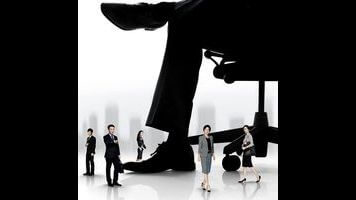Dazzlingly composed around massive wireframe sets, translucent cubes, and grids of intersecting lines that bring to mind both picture frames and prison bars, Office is one of the most original and imaginative musicals of the last decade, in spite of Lo Ta-yu’s largely unremarkable, temp-track-like score. In some respects a lesson in how little the actual music can matter in a movie musical, Johnnie To’s part minimalist, part pop-art corporate fantasy is a feat of direction, crossing class-conscious melodrama with extravagantly realized visuals. Working closely with William Chang, Wong Kar-Wai’s longtime production and costume designer, To (Drug War, Exiled) pulls off a grand experiment in form, turning ostensibly dull subject matter—office culture in Hong Kong’s financial sector—into the stuff of musical dreams.
Best known in the U.S. for his superb crime movies, the prolific, genre-hopping To is one of the foremost living movie craftsmen, with a signature look based on dynamic camera movements, vintage lenses, and meticulous blocking. Craning the camera through a life-size dollhouse cutaway set is a staple of super-stylized direction—be it Jerry Lewis or Wes Anderson—and To’s version is an exploded, ant-colony-like multi-level corporate structure of frames-within-frames and vanishing points, seen mostly in deep focus. And while the music itself is tinny, dated pop-rock, the lyrics read like translations of Brecht art songs, most obviously during a raucous drinking song where the employees of Hong Kong-based Jones & Sunn toast to their own ambition.
Office is set in 2008, as Jones & Sunn gets ready for its IPO, negotiates the purchase of an American cosmetics brand, and prepares for an uncertain future. (The 2008 financial crisis has become something of a pet theme for the director, inspiring both Life Without Principle and Don’t Go Breaking My Heart.) Our entry point into their 71st-floor headquarters is go-getter Lee Xiang (Wang Ziyi), who arrives on the first day of a three-month probationary position eager to make an impression on the bosses. (“Lee as in Ang Lee, Xiang as in ‘dream’” is his refrain.) There, he learns names and coffee preferences in rhyme alongside fellow new hire Kat Ho (Lang Yueting), who, unbeknownst to almost everyone at the company, is actually the Ivy League-educated daughter of the chairman (Chow Yun-Fat), sent to learn the business from the bottom up.
From the high-speed elevator that takes executives straight to the top to the choreographed camera movements that largely stand in for dance in the film, Office is a movie about parallel tracks and characters traveling similar lines at different speeds or in different directions. Besides Lee and Kat, there’s another pair of male-female counterparts: Miss Chang (Sylvia Chang, who adapted the script from her play Design For Living), the strong-willed CEO who has a long-standing affair with Kat’s father, and David (Eason Chan, who really gets to belt it out), the executive undone by his own greed. Office presents international finance as a world motivated by conflicting values of secrecy—from the fudged accounts at the top to the who’s-sleeping-with-whom gossip of the desk drones—and conspicuous consumption, where stage whispers are exchanged at lavish banquets.
To has often taken cues from classic musicals, with Jacques Demy’s Umbrellas Of Cherbourg being a favorite point-of-reference. (However, the movies Office resembles most—and then only in passing—are Demy’s operetta Une Chambre En Ville, set during a strike in a French town in the 1950s, and the Technicolor curio Red Garters, a Rosemary Clooney vehicle shot in a Dogville-like abstraction of a Western town.) For his first official foray into the genre, To brings his usual knack for cutting movement and stunningly composing figures against space to a world of pure stylization. The result puts Hollywood’s recent attempts at reviving the musical to shame.





























![Rob Reiner's son booked for murder amid homicide investigation [Updated]](https://img.pastemagazine.com/wp-content/avuploads/2025/12/15131025/MixCollage-15-Dec-2025-01-10-PM-9121.jpg)











